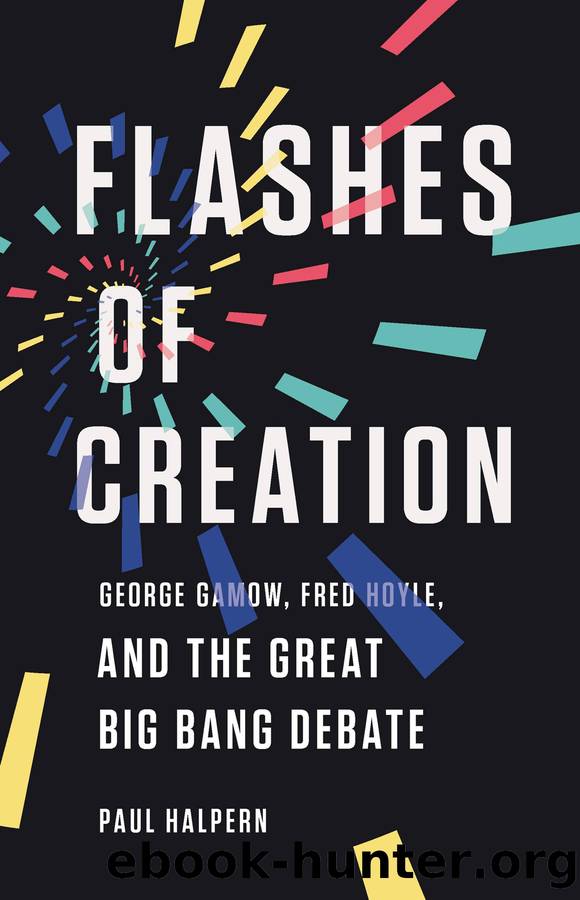Flashes of Creation by Paul Halpern

Author:Paul Halpern [Paul Halpern, PhD]
Language: eng
Format: epub
Publisher: Basic Books
Published: 2021-08-17T00:00:00+00:00
GLIMMERS OF A COSMIC GLOW
Throughout 1948, in preparation for his thesis defense, Alpher worked with Herman to refine the Big Bang nucleosynthesis model. They were startled by how quickly Gamow was releasing papers before they had time to double-check the results. His impulsivity was getting the better of him. Ambitiously, he had completed some rough calculations on his own about early conditions in the universe that might lead to galaxy formation and then hastily sent off his results to the leading science journal Nature as a single-author work. When Alpher and Herman looked over Gamowâs work, they found major computational errors, but it was too late for Gamow to make corrections. Therefore, with his permission, they submitted their own article with their own calculations to Nature, indicating the points in Gamowâs paper that it rectified.
In that work and in a follow-up paper, Alpher and Herman made an astonishingly prescient prediction about the lingering afterglow of the Big Bang. Tracing the hot early radiation as it cooled down over time, they predicted the temperature of space in the current era would be 5 K (Kelvin, or degrees above absolute zero). Penzias and Wilson, in their 1965 paper, find the value to be around 3 K, so Alpher and Herman werenât far off, as it turned out.
Gamow, who would later make his own (higher-temperature) predictions about cosmic background radiation, advised Alpher at the time that the 5 K prediction was essentially meaningless. For some reason Gamow wrongly surmised that the combined effect of shining stars would bathe space in a 5 K glow that would drown out any signs of leftover radiation from the Big Bang any cooler than that. During the summer of 1948 Gamow was in Los Alamos at the invitation of Teller to complete some military research. He wrote to Alpher: âThe only thing we can tell is that the âresidual temperatureâ of the original heat of the universe is not higher than 5 K, but it could be as close to zero as one likes.â13
Arguably, Gamow should have been more patient in reviewing Alpher and Hermanâs results before dismissing their importance. His penchant for rendering hasty judgments and then moving on was the downside of his seat-of-the-pants approach to physics. If the three of them had presented a unified message in the late 1940s about a cooled-down cosmic radiation background, perhaps experimental researchers would have tested that hypothesis sooner. Rather, a serendipitous discovery was matched with the prediction only in hindsight.
On March 18, 1949, Alpher was invited to explain the idea of element production in the hot early universe on the Johns Hopkins Science Review weekly television show. Broadcast to hundreds of thousands of viewers, many of whom had just bought their first television set, the show helped him get the word out about Big Bang nucleosynthesis. As he described on the show (referring to a cosmic age estimate that we now know to be far too low):
Download
This site does not store any files on its server. We only index and link to content provided by other sites. Please contact the content providers to delete copyright contents if any and email us, we'll remove relevant links or contents immediately.
Invention by James Dyson(761)
Thinking Better by Marcus du Sautoy(706)
The Ten Equations That Rule the World by David Sumpter(699)
Concepts of Space by Jammer Max;(679)
God and the Multiverse by Victor J. Stenger(659)
Merchants of Doubt by Erik M. Conway(644)
Wanting by Luke Burgis(644)
How We Got to Now by Steven Johnson(624)
Factfulness by unknow(597)
The Surrender Experiment by Michael A. Singer(571)
The Smallest Lights in the Universe by Sara Seager(532)
On Creativity by Bohm David(522)
Floods, Famines, and Emperors: El Nino and the Fate of Civilizations by Brian Fagan(498)
Ancient Knowledge Networks by Eleanor Robson;(495)
Why Birds Matter by University of Chicago Press(491)
The Scientist and the Psychic by Christian Smith(486)
The Science of Being Lucky: How to Engineer Good Fortune, Consistently Catch Lucky Breaks, and Live a Charmed Life by Peter Hollins(480)
The Oxford Handbook of Philosophy of Mathematics and Logic by Stewart Shapiro(464)
Flood by Design (Design Series) by Mike Oard(440)
